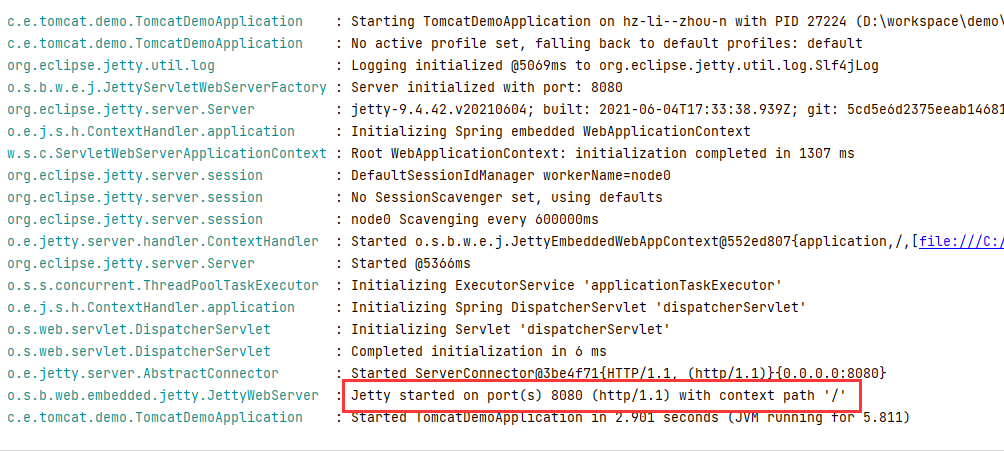一、spring boot内嵌web容器介绍
Spring Boot 支持以下内嵌的 Web 容器:
- Tomcat:Spring Boot 默认使用的 Web 容器,也是最常用的选择。Tomcat 是一个流行的开源 Servlet 容器,具有广泛的应用和良好的性能。
- Jetty:另一个常用的 Web 容器,它具有轻量级和高效的特点。Spring Boot 也提供了对 Jetty 的支持。
- Undertow:一个高性能的 Web 容器,特别适合处理高并发和大规模的应用。Spring Boot 也可以与 Undertow 集成。
这些内嵌的 Web 容器都可以在 Spring Boot 应用中直接使用,无需额外的安装和配置。Spring Boot 会自动根据项目的依赖和配置来选择合适的 Web 容器,并进行相应的配置和启动。
你可以根据项目的需求和特点选择适合的 Web 容器。例如,如果对性能有较高要求,可以考虑使用 Undertow;如果需要与现有 Tomcat 环境集成,则可以选择 Tomcat。
二、如何切换spring boot内嵌web容器
以jetty为例,我们只需要将默认的tomcat依赖排除,并将jetty依赖引入,即可完成内嵌web容器的切换。
<dependency>
<groupId>org.springframework.boot</groupId>
<artifactId>spring-boot-starter-web</artifactId>
<!--1、移除tomcat依赖(exclusions:排除)-->
<exclusions>
<exclusion>
<artifactId>spring-boot-starter-tomcat</artifactId>
<groupId>org.springframework.boot</groupId>
</exclusion>
</exclusions>
</dependency>
<!--2、加入jetty依赖-->
<dependency>
<groupId>org.springframework.boot</groupId>
<artifactId>spring-boot-starter-jetty</artifactId>
</dependency>启动项目,我们可以看到,jetty确实启动了。

三、spring boot内嵌web容器启动原理
Spring Boot 内嵌 Web 容器的启动原理可以概括为以下几个步骤:
- 依赖注入:Spring Boot 在启动时,会自动扫描项目中的依赖,并将相关的 Web 容器依赖注入到应用程序中。
- 容器初始化:Spring Boot 会根据配置文件或默认设置,初始化所选的内嵌 Web 容器。这包括创建容器实例、设置端口号、上下文路径等。
- 组件扫描和注册:Spring Boot 会扫描项目中的组件(如控制器、服务等),并将它们注册到 Web 容器中,以便处理 HTTP 请求。
- 配置加载:Spring Boot 会加载应用程序的配置信息,包括端口号、上下文路径、静态资源路径等,并将这些配置应用到 Web 容器中。
- 启动容器:一旦容器初始化完成并配置好,Spring Boot 会启动内嵌的 Web 容器,使其开始监听指定的端口,并准备处理 HTTP 请求。
- 应用程序运行:此时,应用程序已经在所选的内嵌 Web 容器中运行,可以通过访问指定的端口来访问应用程序的功能。
相关源码如下:
SpringApplication类createApplicationContext方法,根据当前web应用的类型选择匹配的应用上下文类型,这边会创建AnnotationConfigServletWebServerApplicationContext。
protected ConfigurableApplicationContext createApplicationContext() {
Class<?> contextClass = this.applicationContextClass;
if (contextClass == null) {
try {
switch (this.webApplicationType) {
case SERVLET:
contextClass = Class.forName(DEFAULT_SERVLET_WEB_CONTEXT_CLASS);
break;
case REACTIVE:
contextClass = Class.forName(DEFAULT_REACTIVE_WEB_CONTEXT_CLASS);
break;
default:
contextClass = Class.forName(DEFAULT_CONTEXT_CLASS);
}
}
catch (ClassNotFoundException ex) {
throw new IllegalStateException(
"Unable create a default ApplicationContext, please specify an ApplicationContextClass", ex);
}
}
return (ConfigurableApplicationContext) BeanUtils.instantiateClass(contextClass);
}AnnotationConfigServletWebServerApplicationContext类createWebServer方法,会创建我们配置的web容器。
private void createWebServer() {
WebServer webServer = this.webServer;
ServletContext servletContext = getServletContext();
if (webServer == null && servletContext == null) {
ServletWebServerFactory factory = getWebServerFactory();
this.webServer = factory.getWebServer(getSelfInitializer());
getBeanFactory().registerSingleton("webServerGracefulShutdown",
new WebServerGracefulShutdownLifecycle(this.webServer));
getBeanFactory().registerSingleton("webServerStartStop",
new WebServerStartStopLifecycle(this, this.webServer));
}
else if (servletContext != null) {
try {
getSelfInitializer().onStartup(servletContext);
}
catch (ServletException ex) {
throw new ApplicationContextException("Cannot initialize servlet context", ex);
}
}
initPropertySources();
}这边使用了工厂模式,不同的web容器有自己的工厂。

这边我们以TomcatServletWebServerFactory为例,看下它的getWebServerFactory方法。
public WebServer getWebServer(ServletContextInitializer... initializers) {
if (this.disableMBeanRegistry) {
Registry.disableRegistry();
}
Tomcat tomcat = new Tomcat();
File baseDir = (this.baseDirectory != null) ? this.baseDirectory : createTempDir("tomcat");
tomcat.setBaseDir(baseDir.getAbsolutePath());
Connector connector = new Connector(this.protocol);
connector.setThrowOnFailure(true);
tomcat.getService().addConnector(connector);
customizeConnector(connector);
tomcat.setConnector(connector);
tomcat.getHost().setAutoDeploy(false);
configureEngine(tomcat.getEngine());
for (Connector additionalConnector : this.additionalTomcatConnectors) {
tomcat.getService().addConnector(additionalConnector);
}
prepareContext(tomcat.getHost(), initializers);
return getTomcatWebServer(tomcat);
}这边创建了tomcat容器并初始化,然后返回。
































